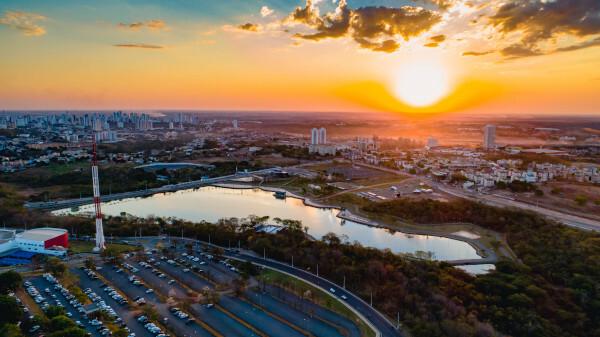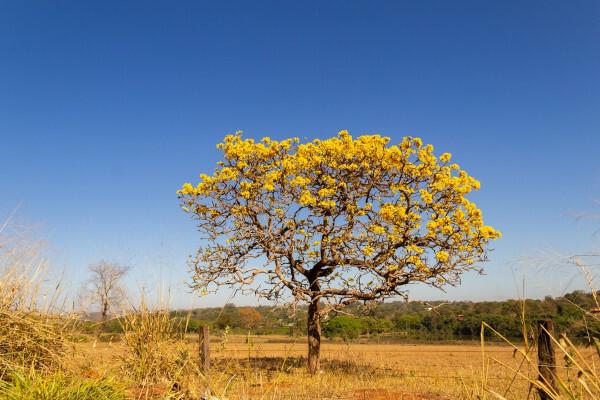O climate of the Midwest region It is predominantly dry and humid tropical, also known as typical tropical. In addition to this, there is in this area of Brazilian territory the following climates:
dry and humid tropical;
highland tropical;
equatorial;
subtropical.
High temperatures are the main characteristic of the tropical climate, which occurs in most parts of of the states of the Center-West, being still marked by the alternation between a rainy summer and a winter dry. The action of climatic factors such as air masses, altitude and vegetation alter atmospheric conditions locally and result in the appearance of other types of climate. In addition, aspects of the climate of the Midwest favor the development of grassland and forest vegetation.
Read too: After all, what is climate?
Summary on the climate of the Midwest region
The Midwest region of Brazil has four types of climate: dry and humid tropical, altitude tropical, equatorial and subtropical.
The typical tropical climate is predominant in this region and is present in all states. It is marked by high average temperatures, low annual temperature range and the occurrence of a dry season (winter) and a rainy season (summer).
The high-altitude tropical climate is present in the higher altitude areas of the Center-West region and is characterized by milder temperatures and higher rainfall.
The equatorial climate occurs in the north of Mato Grosso, close to the border with the states of the North region. It is marked by heat and high humidity, with abundant rainfall.
The subtropical climate occurs in the south of Mato Grosso do Sul only, and is marked by the distinction between the four seasons of the year and by well-distributed rainfall. Winters are cold and can register phenomena such as frost.
The action of air masses, latitude, relief, altitude and continentality are the climatic factors that influence the climate of the Midwest region.
The predominance of the typical tropical climate conditions the formation of characteristic vegetation adapted to alternately dry and wet seasons, which is the Cerrado.
What is the climate of the Midwest region?
The Midwest region of Brazil, formed by the states of Goiás, Mato Grosso, Mato Grosso do Sul and the Federal District, There are four main types of weather:
dry and humid tropical;
highland tropical;
equatorial;
subtropical.
Climate characteristics of the Midwest region
Tropical dry and humid climate: this kind of weather is also called typical tropical, and is the predominant climatic occurrence in the Midwest states of Brazil. All the capitals of this region (Cuiabá, Campo Grande, Goiânia and Brasília) have a typical tropical climate, which has the main feature the alternation between a hot and rainy season, which is the summer, and another mild and dry season, which is the winter.
The dry and humid tropical climate that happens in the Center-West region of Brazil is marked by high average temperatures most of the time and low temperature range Yearly.
Taking into account the capitals, we have that average temperatures vary between 24º C and 26º C for most of the year. The maximums, in turn, can rise a lot, depending on the location and season of the year, exceeding 30º C. Cuiabá, for example, capital of Mato Grosso, frequently registers values between 37 and 40º C during the year, breaking several temperature records. The minimum temperatures are around 20º C, even during the winter.

In the typical tropical climate, the rains are concentrated in the summer months, mainly between the months of November and April. The annual volume of rainfall in this climate, in the Midwest region, varies between 1,200 and 1,500 mm. The driest months of the year are those of winter, especially the month of July, which tends to have very low humidity in most states with a typical tropical climate.
High altitude tropical climate: present in only a few areas of the Center-West region, notably in the Central Plateau, being the climate with less territorial coverage. As the name suggests, this is a variation of the tropical climate that occurs in high altitude terrain. This climatic factor milder temperatures throughout the year, with cool summers and cold winters. The rains are better distributed throughout the year, and during the winter the phenomenon known as frost can occur. To learn more about this climate type, click here.
Equatorial climate: this kind of weather is present only in a stretch of the state of Mato Grosso, which is the northern portion of the territory, which is part of the Amazon biome. In areas where this climate prevails, as is the case of the city of Aripuanã, the heat is predominant in most part of the year, with maximum temperatures that vary between 27º C and 30º C and minimums that tend to be higher than 20º C.
To the rainfall in the equatorial climate is abundant and occurs throughout the year, although they may be less voluminous during the summer months in some locations. In Mato Grosso, annual rainfall in areas with an equatorial climate can reach 2000 mm. To learn more about this climate type, click here.
subtropical climate: this climate is also restricted in terms of its territorial scope, being present only in the southern region of Mato Grosso do Sul. This climate is characterized by the good distinction between the four seasons and by well-distributed rainfall, that is, that it occurs during all months of the year. The annual temperature range of the subtropical climate is high, with hot summers and colder winters. In winter, it is possible that there may be phenomena like the frost.
Read too:What is the climate of the southern region of Brazil?
Factors that influence the climate of the Midwest region
The climate factors are the aspects of the natural environment and the atmosphere that have the capacity to interfere with the elements of the climate, that is, in its characteristics. In view of this, the climatic factors that act directly on the climatic occurrences in the Midwest region of Brazil are detailed below.
Latitude: this factor corresponds to the positioning of the region in the Brazilian territory and on planet Earth. Most of the Midwest region is in the tropical zone, and the incidence of sunlight is high throughout the year. For this reason, the tropical climate is predominant, as well as the high temperatures and intense heat that some cities experience.
Air masses: air masses carry with them the characteristics of their place of origin, changing the time of the places they pass through. In the Central-West region, the tropical continental mass (TcM), which is a hot and dry mass, operates most of the year. Together with it, especially in summer, the continental equatorial mass (mEc) acts, which is hot and humid. In the winter months they lose strength with the approach of the Atlantic polar mass (mPa), a wet and cold mass that arrives with less intensity in the Midwest, but that can drop the temperatures and cause what we call cold.
Vegetation: the humidity of the vegetation, especially in the Amazonian Equatorial Forest, is carried by the winds towards other regions of Brazil, including the Midwest. The north of Mato Grosso is the area most affected by the operation of this system, precisely in the area where the equatorial climate occurs.
Altitude: higher altitude lands have milder temperatures than those lowered, causing discrepancies between the climates of these areas. This difference is identifiable in the Midwest region.
Continentality: the Midwest region is far from the coast of Brazil, which is why maritime status is not a differentiating factor, but continentality is. This factor just does not have greater prominence because of the strong performance of others such as latitude and air masses.
Relationship between climate and vegetation in the Midwest

The climate and vegetation of the Midwest region of Brazil are directly related. As we studied, there is a predominance of a dry season and a rainy season in this area, which conditions the development of a vegetation adapted to the alternation between these very different conditions, as is the case of vegetation cover of the Cerrado. Part of this region has forest cover, notably in more humid climates such as in the north of the state of Mato Grosso. In part of that state and in Mato Grosso do Sul, the plain relief allied to the water regime results in the formation of the typical wetlands of the Pantanal.
Sources:
AYOADE, J. O. Introduction to climatology for the tropics. Rio de Janeiro: Bertrand Brazil, 1996. 4 ed. 332p. Translation by Maria Juraci Zani dos Santos.
DE ALBUQUERQUE CAVALCANTI, Iracema Fonseca; FERREIRA, Nelson Jesuz. Climate of Brazilian regions and climate variability. São Paulo: Oficina de Textos, 201.
G1. With over 40°C, Cuiabá breaks a new heat record for the year and becomes the hottest city in the country. G1 MT, 10 Aug. 2023. Available in: https://g1.globo.com/mt/mato-grosso/noticia/2023/08/10/com-mais-de-40c-cuiaba-bate-novo-recorde-de-calor-no-ano-e-se-torna-a-cidade-mais-quente-do-pais.ghtml.
LUCCI, Elian Alabi. Territory and society in a globalized world, 1: secondary education. São Paulo: Saraiva, 2016. 289p.
MOREIRA, Igor. The geographical space: general geography and Brazil. São Paulo: Editora Ática, 47th edition, 3rd reprint. 455p.
Source: Brazil School - https://brasilescola.uol.com.br/brasil/clima-da-regiao-centro-oeste.htm

